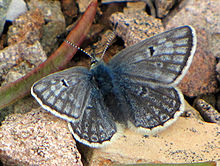Agriades glandon
| Arctic blue | |
|---|---|

| |
| A. g. aquilo, male, Cape Bonavista, Newfoundland and Labrador | |

| |
| Scientific classification | |
| Kingdom: | |
| Phylum: | |
| Class: | |
| Order: | |
| Family: | |
| Subfamily: | |
| Genus: | |
| Species: | A. glandon
|
| Binomial name | |
| Agriades glandon (de Prunner, 1798)
| |
| Synonyms | |
| |
Agriades glandon, the Arctic blue or Glandon blue is a butterfly of the family Lycaenidae.[1] In North America it is found from Alaska east to Newfoundland, south through the mountains to Washington, northern Arizona, and northern New Mexico. In Europe, it is found in mountainous areas like the Pyrenees and Alps, as well as the far north. It is also found in parts of Russia, including Siberia, and Kamchatka.

The wingspan is 17–26 mm. The butterfly flies from mid-May to September depending on the location.[2] The male wing uppersides are silver-coloured, steely blue or pale shining blue and become increasingly brown towards the edges. The female wing uppersides are almost entirely brown but with a slightly bluish pollination in the basal region. The incidence of darkening increases with altitude. All wings usually have small, dark disk spots that are sometimes surrounded by white. Both sexes have white-rimmed black dots on the pale grey-brown ground of the forewing underside, while the underside of the hind wings reveals striking white spots and occasionally orange-colored dots on the greyish-brown ground. Despite a large geographic variability in the pattern of the wing, the species is, in Europe, clearly distinguishable from other bluish species in a complex of three species widely separated geographically.Only 2 species overlap in range that could be confused. In the Alps and the Pyrenees, the more local and less frequent , Plebeius nicias, has fine underside markings and a white stripe. In the Pyrenees, Agriades pyrenaicus, may also fly in the same locations.In this species the underside forewing submarginal spots are bold black not faint grey-brown and the black markings on the underside hindwing are relatively greatly reduced or absent.Other similar species do not overlap in distribution. They are Agriades zullichi (Spain) and Agriades aquilo (Arctic Europe).
Recorded food plants include Astragalus species (including Astragalus alpinus), Androsace species (including Androsace bungeana and Androsace septentrionalis), Soldanella, Diapensia lapponica, Vaccinium, and Saxifraga species (including Saxifraga bronchialis, Saxifraga spinulosa, and Saxifraga oppositifolia).
Subspecies
- A. g. glandon (Pyrenees, Alps)
- A. g. aquilo (Arctic Europe and Arctic Canada)
- A. g. aquilina (polar tundra of Siberia)
- A. g. wosnesenskii (Srednesibirskoe, northeastern Siberia, Kamchatka) has the pale spots of underside smaller and more widely separated from one another, especially on the hindwing.
- A. g. centrohelvetica (Switzerland)
References
- ^ Argiades glandon, Catalogue of Life (LepIndex)
- ^ Arctic Blue, Butterflies of Canada
External links
- Arctic blue, Univ. of Alberta, Entomology Collection
- Arctic blue, Butterflies and Moths of North America
- Lepidoptera of Norway
